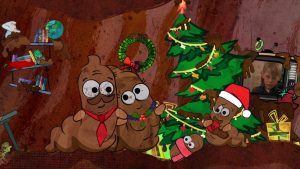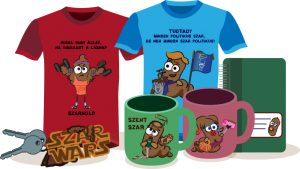
After the outline of the story was solidified, it was time to move on to the visual realization. We knew that what we were doing couldn’t be directly disgusting, as we didn’t want to implicate the client in tastelessness, but it couldn’t be too “weak” either. We needed a look that was tough enough to make people’s jaws drop, but always pulled back to good taste at the last moment. The pop culture has a very famous poop character, Mr. Hankey, the Christmas Poo, so it was especially important for us to be as different from him as possible. The physiology of our characters was basically determined by their distance from Mr. Hankey. They became cute, chubby worms rather than real excrements. Abstraction was a great help to us, as this way even people whose taste didn’t normally tolerate such things could enjoy the film.

The next step was to solidify the production design. Since the film was about the cleaning process, it was clear that we needed to use textures, as they can be cleaned, while completely clean, flat animation cannot. Textures also opened up a wide range of possibilities for us in terms of form: The poo family got a chocolate ice cream texture, and their eye whites were made of used toilet paper. We drew their lines with digital crayons, reinforcing the children’s tale design. The intestine-accommodation itself, the home of The Poo’s, also held a thousand possibilities for jokes. Half-digested objects lay everywhere, and we filled the space with tiny gags so that the fans could nibble on something. Daddy Poo gets paid in corn, the Olympic swimming event is on TV, where the swimmers paint the water brown behind them, and on the wall is a wedding photo of Daddy Poo and Mommy Poo taken in the stomach.
The short film was completed by Péter Csontos’s music and Kata Sarbó’s narration. The narration was written very childish and Kata deliberately went through a wide range of registers, reading the bizarre adventure in a really cute accent. The music provided an emotional boost to the drama in classical film music style, giving the scenes the emotional support they needed.

The “Kakiék nagy kalandja” (The Great Adventure of the Poo’s) exceeded all our expectations in terms of reception. The client had no social media presence or platform previously, so we had to build everything from scratch and without any marketing budget, completely organically. However, the film produced a staggering 400,000 viewers in the first few days, boosting the Facebook channel created for this purpose by 11,000 followers in just one week. Newspaper articles and press releases were created about the Hungarian viral video and it was a topic of conversation among young people for weeks. Later, the series was expanded with two more animated films, one which countered the well-known Fluimucil ad and the other which introduced “Kakiék Szarácsonya” (All I Want For Christmas is Poo). After that, the Poo Family Facebook page also stirred up the audience with weekly images introducing the characters and unexpected merchandising opportunities opened up for our client with requests for items such as a “poo” mug or “poo” t-shirt.

Overall, it can be said that with the right professional work and preparation, it is indeed possible to create successful corporate viral campaigns or viral videos if the product being sold has the shocking or strange element that is necessary. It is important that the topic being advertised is not boring or overly familiar and the client’s flexibility is also necessary to achieve the desired effect. The main challenge for us was to make the animated film rough and shocking in style at the same time, but not tasteless or excessively disgusting. We believe that The Great Adventure of the Poo’s was able to stand on the thin line where virulent marketing content can be effective and tasteful at the same ti


You must be logged in to post a comment.